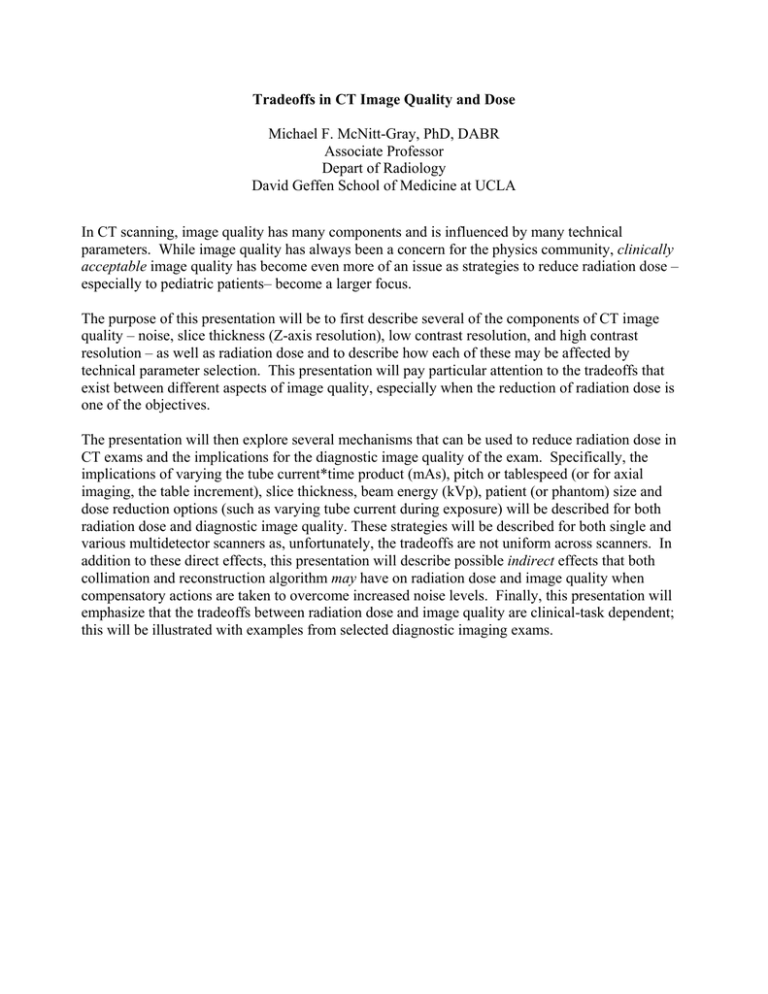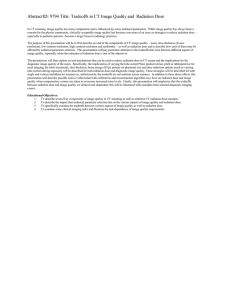Tradeoffs in CT Image Quality and Dose Associate Professor
advertisement

Tradeoffs in CT Image Quality and Dose Michael F. McNitt-Gray, PhD, DABR Associate Professor Depart of Radiology David Geffen School of Medicine at UCLA In CT scanning, image quality has many components and is influenced by many technical parameters. While image quality has always been a concern for the physics community, clinically acceptable image quality has become even more of an issue as strategies to reduce radiation dose – especially to pediatric patients– become a larger focus. The purpose of this presentation will be to first describe several of the components of CT image quality – noise, slice thickness (Z-axis resolution), low contrast resolution, and high contrast resolution – as well as radiation dose and to describe how each of these may be affected by technical parameter selection. This presentation will pay particular attention to the tradeoffs that exist between different aspects of image quality, especially when the reduction of radiation dose is one of the objectives. The presentation will then explore several mechanisms that can be used to reduce radiation dose in CT exams and the implications for the diagnostic image quality of the exam. Specifically, the implications of varying the tube current*time product (mAs), pitch or tablespeed (or for axial imaging, the table increment), slice thickness, beam energy (kVp), patient (or phantom) size and dose reduction options (such as varying tube current during exposure) will be described for both radiation dose and diagnostic image quality. These strategies will be described for both single and various multidetector scanners as, unfortunately, the tradeoffs are not uniform across scanners. In addition to these direct effects, this presentation will describe possible indirect effects that both collimation and reconstruction algorithm may have on radiation dose and image quality when compensatory actions are taken to overcome increased noise levels. Finally, this presentation will emphasize that the tradeoffs between radiation dose and image quality are clinical-task dependent; this will be illustrated with examples from selected diagnostic imaging exams. CT Image Quality- A Summary Image Noise Image noise, in its most simple definition, is measured as the standard deviation of voxel values in a homogenous (typically water) phantom. There are, of course, much more complete definitions of noise that take into account the contrast scale of the scanner (for example, the definition described in AAPM report #39[1]). In this context, we will consider this simple definition and observe that image noise is influenced by a large number of parameters, including: •kVp •mA •Exposure time •Collimation/Reconstructed Slice Thickness •Reconstruction algorithm or filter •Helical Pitch/Table speed •Helical Interpolation Algorithm •Others (Focal spot to isocenter distance, detector efficiency, etc.) For example, reducing the mAs is expected to increase the noise (measured standard deviation) by 1 . Therefore, if the mAs is reduced by ½, then noise should increase by √2 =1.414 à(40% mAs increase). This is illustrated in the water phantom images below where the image on the left was scanned with 100 mA and 0.8 sec scan (80 mAs), while the image of the right was scanned with 50 mA and 0.8 sec scan (40 mAs). The measured standard deviation is nearly 40% higher for the lower mAs scan (17.91 vs. 13.03). (a) (b) Figure 1: (a) water phantom scanned at 100 mA, 0.8 sec scan time (80 mAs), and same phantom scanned at 50 mA, 0.8 sec scan time (40 mAs) and all other parameters identical. Slice Thickness (Z-axis resolution) The reconstructed slice thickness of an image has become much more interesting and complex when going from axial scanning to helical scanning to multidetector helical scanning. For this discussion, we will focus only on the reconstructed slice width in helical scanning and the factors that may influence it, which may include: •X-ray Beam Collimation (especially in single slice CT scanners) •Detector Width (especially in multidetector CT scanners) •Helical Pitch/Table speed •Helical Interpolation Algorithm Note: For some manufacturers multidetector scanners, the reconstructed slice thickness is independent of table speed; this is because of the interpolation algorithm used. Hence, these last two items are tightly linked. For single detector helical scanners using either the 180 LI or 360 LI interpolation algorithm, the results were quite clear that higher table speeds produced larger effective slice thicknesses [2, 3]. For multidetector helical scanners, these trends are not quite so clear because of the ability to interpolate data collected from multiple detectors and because of the different interpolation algorithms available [4]. Figure 2 illustrates that in one multidetector scanner, the table speed can affect the slice sensitivity profile and effective slice thickness. The top curve was obtained using 4 x 5mm collimation mode, pitch of 0.75 (table speed of 15 mm/rot) and a nominal reconstructed slice thickness of 5mm; the calculated FWHM was 5.31 mm. The bottom curve was obtained using the same parameters except that the pitch was increased to 1.5 (30 mm/rot) and the resulting calculated FWHM was 6.24 mm; a 17% increase. Intensity in HU Slice Sensitivity Profiles 200 180 160 140 120 100 80 60 40 20 0 5 mm HQ 15mm/rot 5 mm HS 30 mm/rot 0 5 10 15 20 distance in mm Figure 2. Differences in Slice Sensitivity Profile due to differences in table speed with all other factors held constant in a Multidetector helical CT scanner (GE LightSpeed Qx/I, GE Medical Systems, Milwaukee, WI). High Contrast (Spatial) Resolution The high contrast or spatial resolution of the system is often determined using objects having a large signal to noise ratio. This test measures the system’s ability to resolve high contrast objects of increasingly smaller sizes (increasing spatial frequencies). Several quantitative methods (scanning a wire to calculate the modulation transfer function - MTF - or scanning a bar pattern phantom to calculate MTF using the Droege-Morin approach [5]) have been described. High contrast spatial resolution is influenced by factors including: • System geometric resolution limits – focal spot size, detector width and ray sampling, • Pixel size • Properties of the convolution kernel/mathematical reconstruction filter Typically, those reconstruction filters that enhance or preserve the higher spatial frequencies (smaller objects) do so at the cost of increased noise in the image. For high signal to noise objects, this tradeoff is usually acceptable. These concepts are illustrated below. Figure 3 shows the MTF of two different reconstruction filters (using the Droege-Morin method) measured on a multidetector scanner (GE LightSpeed Qx/I). This figure shows that the “Bone” algorithm maintains a higher amplitude modulation than the “Standard” algorithm. Figure 4 illustrates the impact of these two reconstruction algorithms on noise for two water phantom images. The measured standard deviation from “Bone” algorithm is 45.36, and 11.88 from “Standard” algorithm. MTF GE LightSpeed 1 Amplitude 0.75 Standard 0.5 Bone Figure 3. Modulation Transfer Function (MTF) of two reconstruction algorithms from the same multidetector CT scanner (GE LightSpeed Qx/I). 0.25 0 0 2 4 6 8 10 12 spatial frequency lp/cm (a) (b) Figure 4: Water phantom reconstructed with (a)“Standard” algorithm and (b) “Bone” algorithm Low Contrast Resolution The low contrast resolution of the system is often determined using objects having a very small difference from background (typically from 4-10 HU difference). In this case, because the signal (the difference between object and background) is so small, noise is a significant factor in this test. This test measures the system’s ability to resolve low contrast objects of increasingly smaller sizes (increasing spatial frequencies). While several purely quantitative methods have been proposed, the most widely accepted methods are still those that require an observer to subjectively detect objects as distinct. An example of a low contrast resolution phantom is that in use by the American College of Radiology (ACR) CT Accreditation program and is shown in Figure 5. This phantom consists of 1 25mm rod for reference and measurements, and then sets of 4 rods where each set is decreasing in diameter, starting with 6mm, 5mm, 4mm on down to 2mm (typically not visible unless a very, very high technique is used). Low contrast resolution is influenced by a large number of factors that include a similar list to that described above for image noise. The actual test results can also be influenced by factors such as window and level settings, the monitor or film calibration curve and the observer themselves. Figure 5 illustrates just one aspect of the low contrast resolution test and how noise – as created by different mAs levels – can influence the results of this test (Note that the reader’s printer or computer monitor may also significantly affect the appearance of these images). Under good viewing conditions, the 4 mm diameter rods can be seen on the image on the left; while even the 6 mm diameter rods are questionable on the right hand image. (a) (b) Figure 5. ACR CT accreditation phantom low contrast module imaged under two different noise conditions on the same scanner with: (a) 240 mAs and (b) 80 mAs. Radiation Dose The radiation dose measured in phantoms by a particular imaging protocol –as described by CTDIvol and described in [6] - is influenced my many technical factors, including: •kVp •mA •Exposure time • X-ray Beam collimation • Pitch (Table Speed) • Dose Reduction Options (such as tube current modulation techniques) • Scanner make and model specifics (which include beam spectra, bowtie filter and geometry such as distance from focal spot to isocenter) • Indirect Effects of Algorithm and Collimation Several of these parameters have been described as possible mechanisms to reduced radiation dose to patients – and to pediatric and small adult patients in particular [7]. These included recommendations to: •Reduce tube current (mA) •Increase table increment (axial) or pitch •Develop mA settings based on patient weight (or diameter) and body region •Reduce number of multiple scans w/contrast •Eliminate inappropriate referrals for CT While the last two items have to do with referral patterns and appropriate usage of CT, the first three have implications for image quality. Tradeoffs between Radiation Dose and Image Quality As parameters are varied to reduce radiation dose, the impacts on image quality must be considered as there are often direct tradeoffs between the two. Where the level of acceptable tradeoff in image quality lies may be dependent on the clinical task at hand. Some examples of tradeoffs include: • Reducing mAs: o Reduces radiation dose in proportion to reduction in mAs, o But increases image noise in proportion to (mAs original ) / (mAs reduced ). Therefore, if the mAs is reduced to ½ of the original, then the noise is expected to increase by 1.41 (41% increase). As illustrated above, this should degrade the low contrast resolution performance • Increase table speed or pitch: o Reduces radiation dose in proportion to the increase in pitch (UNLESS scanner automatically increases mA with increase in pitch as Siemens and Philips multidetector CT scanners do). o But, may increase slice sensitivity profile, creating larger effective slice thickness and reducing z-axis resolution. • Reducing kVp: o Reduces radiation dose (though not linearly with kVp), o May increase signal contrast for some tissues and iodine (High Z) due to increased photoelectric o May significantly increase beam hardening artifact if beam energy gets too low (e.g. 80 kVp) • Indirect Effects: o When thinner slices or high spatial frequency filters are used, with all other factors held constant, noise increases. o To compensate for increase in noise, user may be inclined to increase the mAs, which in turn will increase radiation dose. Influence of the Clinical Task on Determining Acceptable Image Quality Different clinical tasks have different requirements for image quality. Some examples are: • High Signal to Noise Tasks o Solid nodule detection in the lung (Exception is the ground glass nodule) o Coronary artery calcium detection. o Identification of Emphysema in lung • Low Signal to Noise Tasks o Abdominal Scans (liver or kidney lesion detection) o Diffuse Lung Disease • Medium Signal to Noise Tasks o Brain o Peds Abdomen/Chest (Rule out Bleeds) Lung Disease Summary: There are many tradeoffs in image quality and many times the different image quality characteristics are inter-related. Noise versus spatial resolution radiation dose is one example. Methods to reduce radiation dose may involve tradeoffs in image quality (increase in noise, decrease in low contrast resolution, etc.). Different clinical imaging tasks have different requirements in terms of acceptable image quality. The more clearly defined the objectives of a clinically indicated study, then the more clearly the image quality requirements can be determined. In an effort to reduce radiation dose, the effect on physical image quality and the ability to carry out the clinical imaging task must be considered. References [1] AAPM Report # 39 Specification and Acceptance Testing of Computed Tomography Scanners [2]. Polacin A; Kalender WA; Marchal G. Evaluation of section sensitivity profiles and image noise in spiral CT. Radiology, 1992 Oct, 185(1):29-35. [3]. Polacin A; Kalender WA; Brink J; Vannier MA. Measurement of slice sensitivity profiles in spiral CT. Medical Physics, 1994 Jan, 21(1):133-40. [4] McCollough CH, Zink FE. Performance evaluation of a multi-slice CT system. Med Phys 1999; 26:2223–2230. [5] Droege RT, Morin RL A practical method to measure the MTF of CT scanners. Med Phys 1982 Sep-Oct; 9(5):758-760. [6] McNitt-Gray, “Radiation dose in CT,” Radiographics 22:1541-1553 (2002) [7] FDA Notice dated 11-2-01 http://www.fda.gov/cdrh/safety/110201-ct.html




